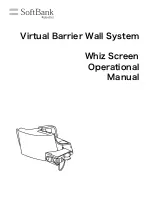
Paramount MX User Guide
19 |
P a g e
2.
Choose the
Verify TheSkyX Time
command from the
Tools
menu to make sure you computer’s
time matches an independent time source.
3.
Choose the
Connect
command from the
Telescope
menu. The mount
Status
text will show
Not
Homed
.
4.
Choose the
Find Home
command from the
Start Up
pop-up menu on the
Telescope
window.
The mount will slew to the home position. The mount
Status
text will show
Not Synced
.
5.
Choose the
Turn Tracking Off
command from the
Tools
pop-up menu on the
Telescope
window.
Turn tracking off to pin the mount to this position.
6.
Choose the
TPoint Add On
command from the
Telescope
menu.
7.
Then turn off the
Apply Pointing Corrections
checkbox on the
Setup
tab and click
Close
. TPoint
will change the position of the telescope cross hairs based on the current model and we want
the label to show the “unmodeled” cross hair position.
8.
Click on the center of the telescope cross hair and note the exact altitude and azimuth of this
position. This horizon-based coordinate of the home position.
9.
Choose the
My Chart Elements
command from the
Input
menu.
10.
Click the
Add Object
button (the upper left most button on the
Manage
tab), then click the
Add
and Edit
button to add an object to the Sky Chart.
11.
On the
Add/Edit Chart Element
window, turn on the
Horizon
radio button, then enter the
azimuth (
Azm
) and altitude (
Alt
) of the telescope cross hair. In the
Label
text box, enter the text
Absolute Home Position
and then click
OK
.
The Sky Chart now shows a label at the absolute home position of the mount. To double-check the
accuracy of this position, choose the
Find Home
command. Note that, when compared to the absolute
home position, the position of the telescope cross hairs on the Sky Chart will also be affected by the
following:
•
Synchronizing the mount on a star introduces small pointing errors.
•
A TPoint pointing model will change the position of the telescope cross hairs based on the
pointing calibration data.
The above two items necessarily introduce a small offset between the mount’s absolute home position
and the position of the telescope cross hairs after finding home (once the mount has been synchronized
and a TPoint model is established).
Synchronization
Synchronizing (or “syncing”) the Paramount MX initializes the control system to a specific equatorial
coordinate. Synchronization involves centering a known star in the eyepiece, identifying this star in
TheSkyX Professional Edition
then choosing the
Synchronize
command from the
Start Up
pop-up menu
on the
Telescope
window.
Once the Paramount MX has been synchronized on a star,
TheSkyX Professional Edition
uses the
equatorial coordinates of the star to determine the mount’s mechanical orientation and software slew
















































